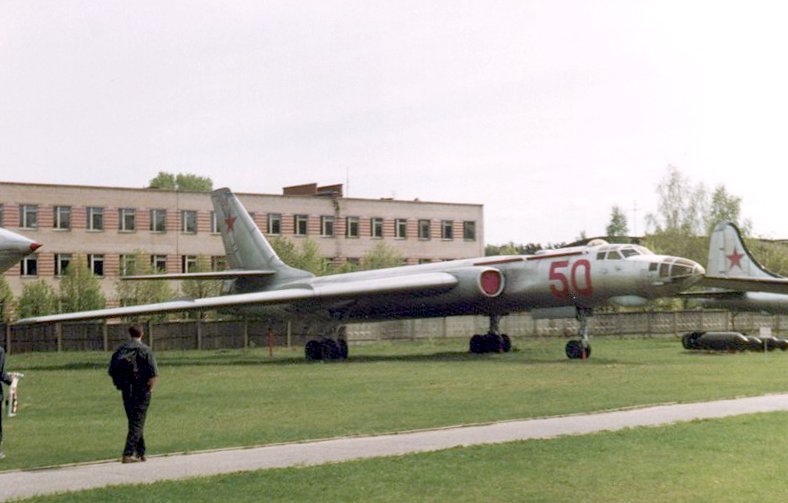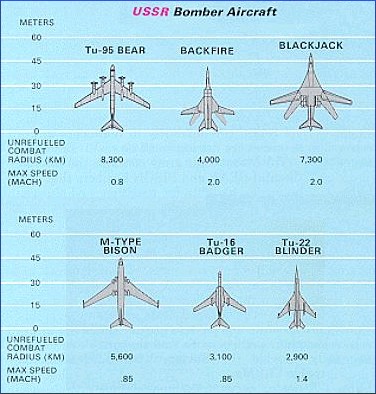|
AS-1 Kennel
The Raduga KS-1 Komet (russian: КС-1 "Комета", NATO reporting name: Kennel), also referred to as AS-1 and KS-1 (крылатый снаряд - winged projectile) was a Soviet short range air-to-surface missile, primarily developed for anti-ship missions. It was carried on two aircraft, the Tupolev Tu-4 and the Tupolev Tu-16. Development Development begun in 1947 along with a related ground-launched missile, the SSC-2B "Samlet" (S-2 Sopka), both missiles using aerodynamics derived from the Mikoyan-Gurevich MiG-15 fighter aircraft, and developed under the anti-ship missile codename "Komet". The KS-1 was designed for use against surface ships. It resembled a scaled-down MiG-15 with the cockpit and undercarriage removed. Its main fuselage was cigar-shaped with swept wings and an aircraft type tail. It was propelled by a Klimov RD-500K turbojet engine, reverse-engineered from the Rolls-Royce Derwent. Guidance was provided by an inertial navigation system (INS) in the mid ... [...More Info...] [...Related Items...] OR: [Wikipedia] [Google] [Baidu] |
Tupolev Tu-16
The Tupolev Tu-16 (NATO reporting name: Badger) is a twin-engined jet strategic heavy bomber used by the Soviet Union. It has been flown for almost 70 years, and the Chinese license-built Xian H-6 remains in service with the People's Liberation Army Air Force. Development In the late 1940s, the Soviet Union was strongly committed to matching the United States in strategic bombing capability. The Soviets' only long-range bomber at the time was Tupolev's Tu-4 'Bull', a reverse-engineered copy of the American B-29 Superfortress. The development of the notably powerful Mikulin AM-3 turbojet led to the possibility of a large, jet-powered bomber. The Tupolev design bureau began work on the Tu-88 ("Aircraft N") prototypes in 1950. The Tu-88 first flew on 27 April 1952. After winning a competition against the Ilyushin Il-46, it was approved for production in December 1952. The first production bombers entered service with Frontal Aviation in 1954, receiving the service designatio ... [...More Info...] [...Related Items...] OR: [Wikipedia] [Google] [Baidu] |
Rolls-Royce Derwent
The Rolls-Royce RB.37 Derwent is a 1940s British centrifugal compressor turbojet engine, the second Rolls-Royce jet engine to enter production. It was an improved version of the Rolls-Royce Welland, which itself was a renamed version of Frank Whittle's Power Jets W.2B. Rolls-Royce inherited the Derwent design from Rover when they took over their jet engine development in 1943. Design and development Rover When Rover was selected for production of Whittle's designs in 1941 they set up their main jet factory at Barnoldswick, staffed primarily by Power Jets personnel. Maurice Wilks was also aware of the potential of a more efficient straight-through design. This layout had already been used by Whittle in his drawings of the W2Y and W3X and was also being pursued by the de Havilland Company with the Halford H.1. Wilks set up a design office at Waterloo Mill, Clitheroe with Adrian Lombard leading the design of an engine with this configuration. The design was done in secret ... [...More Info...] [...Related Items...] OR: [Wikipedia] [Google] [Baidu] |
Soviet Air Forces
The Soviet Air Forces ( rus, Военно-воздушные силы, r=Voyenno-vozdushnyye sily, VVS; literally "Military Air Forces") were one of the air forces of the Soviet Union. The other was the Soviet Air Defence Forces. The Air Forces were formed from components of the Imperial Russian Air Service in 1917, and faced their greatest test during World War II. The groups were also involved in the Korean War, and dissolved along with the Soviet Union itself in 1991–92. Former Soviet Air Forces' assets were subsequently divided into several air forces of former Soviet republics, including the new Russian Air Force. "March of the Pilots" was its song. Origins The ''All-Russia Collegium for Direction of the Air Forces of the Old Army'' (translation is uncertain) was formed on 20 December 1917. This was a Bolshevik aerial headquarters initially led by Konstantin Akashev. Along with a general postwar military reorganisation, the collegium was reconstituted as the "Workers' ... [...More Info...] [...Related Items...] OR: [Wikipedia] [Google] [Baidu] |
Long Range Aviation
Long-Range Aviation ( rus, Авиация Дальнего Действия, r=Aviatsiya dal'nego deystviya, abbr. to AДД, or ADD, and literally ''Aviation of Distant Action'') is a branch of the Russian Aerospace Forces responsible for delivering long-range nuclear or conventional strikes by aircraft rather than missiles. The branch was previously part of the Soviet Air Forces and Russian Air Force tasked with long-range bombardment of strategic targets with nuclear weapons. During the Cold War, it was the counterpart to the Strategic Air Command of the United States Air Force. Origins, 1936-1940 The first three Air Armies, designated Air Armies of Specific Purpose (or Particular Purpose) were created between 1936 and 1938. In accordance with the predominant Deep operations doctrine, the Red Army was reorganized into six echelons, of which the long-range aviation was the 1st echelon. The 2nd echelon consisted of: heavy tanks; the 3rd echelon: medium and light tanks; the ... [...More Info...] [...Related Items...] OR: [Wikipedia] [Google] [Baidu] |
Indonesian Air Force
The Indonesian Air Force ( id, Tentara Nasional Indonesia Angkatan Udara (TNI-AU), literally "''Indonesian National Military-Air Force''") sometimes shortened as IDAF / IdAF, is the aerial branch of the Indonesian National Armed Forces. The Indonesian Air Force is headquartered in Jakarta, Indonesia and is headed by the Chief of Staff of the Air Force ( id, Kepala Staf Angkatan Udara – KSAU or KASAU). Its order of battle is split into three Air Operations Commands ( id, Komando Operasi Udara). Most of its airbases are located on the island of Java. The Indonesian Air Force also has its ground force unit, called Air Force Quick Reaction Force Command ( Kopasgat). The corps is also known as the "Orange Berets" () due to the distinctive color of their service headgear. The Indonesian Air Force has 37,850 personnel and equipped with 110 combat aircraft. The inventory includes five Su-27 and eleven Su-30 as the main fighters (from Russia) supplemented by 33 F-16 Fighting Falco ... [...More Info...] [...Related Items...] OR: [Wikipedia] [Google] [Baidu] |
Egyptian Air Force
The Egyptian Air Force (EAF) ( ar, القوات الجوية المصرية, El Qūwāt El Gawīyä El Maṣrīya), is the aviation branch of the Egyptian Armed Forces that is responsible for all airborne defence missions and operates all military aircraft, including those used in support of the Egyptian Army, Egyptian Navy and the Egyptian Air Defense Forces. The latter was created as a separate command in the 1970s and it coordinates with the Air Force to integrate air and ground-based air defense operations. The EAF is headed by an air marshal (lieutenant general equivalent). Currently, the commander of the Egyptian Air Force is Air Marshal Mohamed Abbas Helmy. The force's motto is 'Higher and higher for the sake of glory' ( ar, إلى العلا في سبيل المجد, '). It was known as the Royal Egyptian Air Force until 18 June 1953 following the declaration of the Republic of Egypt by Muhammad Naguib. The Egyptian Army Air Service was formed in 1932, and became ... [...More Info...] [...Related Items...] OR: [Wikipedia] [Google] [Baidu] |
Cuban Navy
The Cuban Revolutionary Navy ( es, Marina de Guerra Revolucionaria) is the navy of Cuba. History The Constitutional Navy of Cuba was the navy of Cuba that existed prior to 1959. During World War II, it sank the German submarine ''U-176'' on 15 May 1943. During the Cold War, the Cuban Navy successfully captured the freighters Leyla Express and Johnny Express, both vessels blamed for CIA-related activities against Cuba. In 1988, the Cuban Navy boasted 12,000 men, three submarines, two modern guided-missile frigates, one intelligence vessel, and a large number of patrol craft and minesweepers. However, most of the Soviet-made vessels have been decommissioned or sunk to make reefs. By 2007, the Cuban Navy was assessed as being 3,000 strong (including up to 550+ Navy Infantry) by the IISS with six Osa-II and one . The Cuban Navy also includes a small marine battalion called the ''Desembarco de Granma''. It once numbered 550 men though its present size is not known. Cuban ... [...More Info...] [...Related Items...] OR: [Wikipedia] [Google] [Baidu] |
KS-1 Operators , a British primary educational term
{{Letter-NumberCombDisambig ...
KS1 or KS-1 may refer to: Weapons * KS-1 (missile), a Chinese surface-to-air missile * Raduga KS-1 Komet, a Soviet anti-ship missile Other uses * Kansas's 1st congressional district, to the United States House of Representatives * K-1 (Kansas highway), an American road * Key Stage 1 Key Stage 1 is the legal term for the two years of schooling in maintained schools in England and Wales normally known as Year 1 and Year 2, when pupils are aged between 5 and 7. This Key Stage normally covers pupils during infant school, although ... [...More Info...] [...Related Items...] OR: [Wikipedia] [Google] [Baidu] |
AS-5 Kelt
The Raduga KSR-2 ( NATO reporting name: AS-5 "Kelt") was a Soviet cruise missile developed to replace the KS-1 Komet (NATO: AS-1 "Kennel"). It was developed in 1958 and entered service in 1962. The missile was normally armed with a conventional high-explosive warhead, although it could be fitted with a one-megaton nuclear warhead. Development Flight testing of the missile as part of the K-16 weapon system in 1958, with two missiles being carried on BD-352 pylons under the wings of a modified Tu-16 bomber designated as Tu-16KSR-2. The bomber was fitted with a newly developed Roobin-1K (Ruby) search and target illumination radar which has a maximum range of approximately 200 kilometers. During the tests, missiles were fired at ships and ground targets. Description The missile itself, like the earlier KS-1, is extremely large, nearly nine meters in length with a wingspan of approximately four and a half meters and weighing 4,000 kilograms. It has swept wings with two wing fences ... [...More Info...] [...Related Items...] OR: [Wikipedia] [Google] [Baidu] |
Indonesia
Indonesia, officially the Republic of Indonesia, is a country in Southeast Asia and Oceania between the Indian and Pacific oceans. It consists of over 17,000 islands, including Sumatra, Java, Sulawesi, and parts of Borneo and New Guinea. Indonesia is the world's largest archipelagic state and the 14th-largest country by area, at . With over 275 million people, Indonesia is the world's fourth-most populous country and the most populous Muslim-majority country. Java, the world's most populous island, is home to more than half of the country's population. Indonesia is a presidential republic with an elected legislature. It has 38 provinces, of which nine have special status. The country's capital, Jakarta, is the world's second-most populous urban area. Indonesia shares land borders with Papua New Guinea, East Timor, and the eastern part of Malaysia, as well as maritime borders with Singapore, Vietnam, Thailand, the Philippines, Australia, Palau, and India ... [...More Info...] [...Related Items...] OR: [Wikipedia] [Google] [Baidu] |
Egypt
Egypt ( ar, مصر , ), officially the Arab Republic of Egypt, is a transcontinental country spanning the northeast corner of Africa and southwest corner of Asia via a land bridge formed by the Sinai Peninsula. It is bordered by the Mediterranean Sea to the north, the Gaza Strip of Palestine and Israel to the northeast, the Red Sea to the east, Sudan to the south, and Libya to the west. The Gulf of Aqaba in the northeast separates Egypt from Jordan and Saudi Arabia. Cairo is the capital and largest city of Egypt, while Alexandria, the second-largest city, is an important industrial and tourist hub at the Mediterranean coast. At approximately 100 million inhabitants, Egypt is the 14th-most populated country in the world. Egypt has one of the longest histories of any country, tracing its heritage along the Nile Delta back to the 6th–4th millennia BCE. Considered a cradle of civilisation, Ancient Egypt saw some of the earliest developments of writing, agriculture ... [...More Info...] [...Related Items...] OR: [Wikipedia] [Google] [Baidu] |



